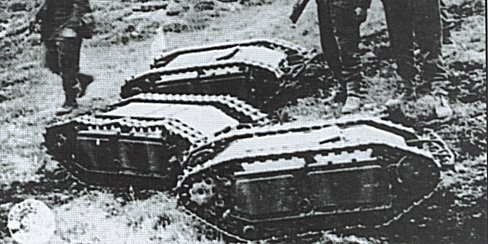

Posted on 06/27/2004 1:06:05 AM PDT by endthematrix
Carnegie Mellon University robotics researchers, in conjunction with the U.S. Marine Corps' Warfighting Laboratory, have developed a small, throwable, remote-controlled prototype robot designed for surveillance in urban settings. Several of the robots are being sent to Iraq for testing. The robot, known as Dragon Runner, has the ability to see around corners and deliver information to Marines while keeping them out of danger in urban settings where human access is impractical, dangerous or unsustainable.
The Dragon Runner project is managed and funded by the Warfighting Laboratory (Quantico, Va.), which is part of the Marine Corps Combat Development Command. The system has been under development for more than two years and has already undergone rigorous testing in a variety of austere environments.
"The Dragon Runner can function in loose soil with small obstacles but is most effective on relatively flat surfaces like streets and sidewalks, making it ideal for an urban, desert environment," said Captain Dave Moreau, Dragon Runner Project Officer with the Marine Corps Warfighting Lab.
"We have conducted a thorough evaluation of its capabilities in an urban, desert environment at both the former George Air Force Base, in Victorville, Calif., and Southwest Research Institute, San Antonio, Texas. The next step is to test Dragon Runner operationally in theater."
The architect behind Dragon Runner is Hagen Schempf, a principal research scientist in Carnegie Mellon's Robotics Institute. During his career, Schempf has designed robotic systems for asbestos removal, nuclear waste remediation and cleanup of underground storage tanks containing toxic materials.
"Dragon Runner is the lightest, smallest, most rugged, readily portable robot system for remote scouting operations in existence today," he said. "It has the potential to be the eyes and ears of the Marines in forward urban operations, allowing them to gather intelligence without being in harm's way. It is a tool that reduces potential lethal exposure to our troops by reducing the amount of time that they expose themselves to danger."
The Warfighting Laboratory describes Dragon Runner as a small, four-wheeled, all-wheel drive, invertible, tossable, remotely operated, low-cost, man-portable, mobile ground sensor designed to increase situational awareness at the small unit level (i.e., company and below) in urban environments.
In today's modern battle spaces, potential enemies capitalize on the asymmetric nature of urban areas. In response, Dragon Runner can provide real-time imagery of tactical objectives and potential danger areas beyond a Marine's line of sight during day or night.
Dragon Runner can stand in sentry mode by using several onboard motion and audio sensors to monitor selected areas. It may also be configured to carry mission-specific payloads. The complete system includes the vehicle, an operator control system and a controller configured for one-handed operation, all held in a custom backpack.
Dragon Runner has a top speed of more than 20 miles per hour but also can be operated with slow deliberate control. It operates in a mode similar to modern video games and can be deployed from its backpack in less than three seconds.
In addition to his work at the Robotics Institute, Schempf is chief scientist at Automatika, a Pittsburgh-based company he founded in 1995, that develops novel, high-value-added robotic and automation systems. Automatika was responsible for the development of Dragon Runner's rugged distributed vehicle electronics and the development of its impact-tolerant chassis and shell.
Automatika has licensed the Dragon Runner technology from Carnegie Mellon to explore the civilian opportunities for such a system. They believe there could be a variety of uses, i.e., in civil defense, SWAT, protecting the nation's borders and in criminal defense.
Schempf emphasized that after testing is complete, the university will not be involved in developing a military version of the system, which the Marine Corps may wish to procure through its military acquisition channels.
"What we're doing is not classified," he said. "It's about developing a new operational capability using innovative technologies and cutting-edge manufacturing and assembly methods."
According to William A. Thomasmeyer, president of the Robotics Foundry, an independent, non-profit economic development organization that directs programs and initiatives to accelerate the growth of an applied robotics industry in western Pennsylvania, Automatika is on track to become a robotics success story.
"If Dragon Runner is able to prove its mettle, it's likely to become the first mass-produced, agile, robotic product to be invented, engineered and manufactured in southwestern Pennsylvania," he said.
I've got a throwable laptop-- not really remote-controllable, though-- in fact, it doesn't even work very well if you're typing right on it...
..ZOT! :p
How would these robots cross a trench?
They had robot car bombs
The Germans had them in WW II. called Goliath.
Used to blow tanks and hard points, bunkers etc.
Small tracked vehicles, wire guided.
Wait for the new F600
ping


I don't remember a Clint Eastwood movie; but I remember a not-too-great Tom Selleck one.
I want one that emits the Howard Dean scream when you throw it.
I would think that a big trench with steep walls would stop any small robot. These small robots are designed for urban warfare where the robots can drive on relatively smooth streets and our adversaries will not be dug in deep. You probably need a UAV or toy chopper for a battfield out in the country where the enemy is dug into trenches and bunkers.
Disclaimer: Opinions posted on Free Republic are those of the individual posters and do not necessarily represent the opinion of Free Republic or its management. All materials posted herein are protected by copyright law and the exemption for fair use of copyrighted works.